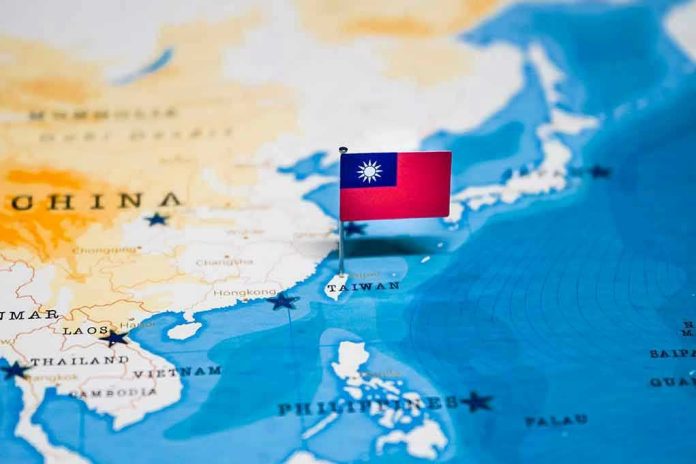
China just green-lit a new flight path skimming the Taiwan Strait’s median line—a move so brazen, even the most jaded among us will wonder how much longer the world will pretend this is about “civilian air traffic.”
At a Glance
- China unveiled a third extension of the M503 air route, pushing civilian flights closer to Taiwan than ever before.
- Taiwan’s government condemned the change as a direct threat to regional stability—timed just days before critical military drills.
- Beijing claims the expansion is “for safety and convenience,” but experts warn it undermines Taiwan’s autonomy and the long-standing buffer zone.
- International aviation authorities are sidelined while China chips away at the status quo, one technicality at a time.
China’s New “Civilian” Flight Path: Nothing to See Here?
On July 6, 2025, the People’s Republic of China opened a third extension—dubbed W121—of the controversial M503 air route, bringing civilian air traffic within a hair’s breadth (just 7.8 kilometers) of the Taiwan Strait’s median line. For anyone keeping score, that’s the same median line Beijing pretends doesn’t exist, while everyone else treats it as the last thin buffer between “routine civil aviation” and a potential geopolitical firestorm. The new route joins two previous extensions, W122 and W123, both activated in 2024—each time, inching closer and closer to Taiwan’s airspace, each time waved away by Beijing as a technical fix to alleviate “congestion.”
Let’s get real. When China says it’s about “safety and efficiency,” it’s like the IRS saying they’re just here to help you balance your checkbook. Taiwan’s government isn’t buying it. Their Mainland Affairs Council blasted this latest move as a “unilateral attempt to change the status quo”—a phrase that’s become code for “we see exactly what you’re doing, and it’s not fooling anyone.” The timing is no accident. This air route expansion comes just three days before Taiwan launches its annual Han Kuang military exercises—drills specifically designed to simulate a Chinese invasion. You can bet your last dollar Beijing’s “civilian” air traffic will be closely watched for anything that looks remotely like military posturing, or worse, a pretext for something more aggressive.
Taipei Protests, Beijing Shrugs, and the World Looks Away
Taiwan’s response amounted to a diplomatic shout into the void—official condemnation, calls for international attention, and warnings about the risk of accidental confrontation. Beijing’s Taiwan Affairs Office, meanwhile, stuck to its well-worn script: the change is “routine,” “benefits both sides,” and—here’s the kicker—“ensures safety.” Anyone who’s watched politicians explain away government overreach or bureaucratic power grabs will recognize the playbook. The Civil Aviation Administration of China, the regulatory body behind these changes, parrots the official line about public good, all while chipping away at what little remains of Taiwan’s de facto sovereignty.
The International Civil Aviation Organization, which approved the original M503 route back in the mid-2000s, is nowhere to be found. Why? Because when it comes to sovereignty disputes, international bureaucrats are always conveniently “out to lunch.” Airlines and passengers might get slightly more efficient routes, but in exchange, they’re flying through what amounts to a militarized pressure cooker—no extra charge for the anxiety. If you think that’s a fair trade, you probably also think government spending sprees are a sound economic strategy.
Strategic Erosion of the Status Quo—One Technicality at a Time
Every extension of the M503 route is a masterclass in the art of the “gray zone”—slowly changing facts on the ground without firing a shot. Aviation and security analysts, not given to hyperbole, point out that the stated reasons for these changes (like post-pandemic air traffic surges) don’t match the reality. What does match the reality? A pattern of Beijing moving the goalposts, normalizing its presence over the strait, and daring the world to do something about it. Each incremental change is small enough to avoid immediate confrontation, big enough to matter.
The impact goes well beyond Taiwan. Neighboring countries, the U.S., and the entire aviation industry are forced to operate in an environment where the rules are being rewritten in real time, with no recourse to international norms or legal authority. The people of Taiwan, meanwhile, are left to wonder how many more “technical adjustments” it will take before the buffer is gone for good. And make no mistake: as long as the world keeps looking the other way, Beijing will keep pushing—one flight path, one technicality, one “routine” change at a time.
Sources:
AeroTime: “China adds new M503 route near Taiwan, triggering protest” (July 6, 2025)






